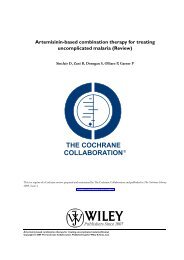Antiamoebic drugs for treating amoebic colitis - The Cochrane Library
Antiamoebic drugs for treating amoebic colitis - The Cochrane Library
Antiamoebic drugs for treating amoebic colitis - The Cochrane Library
Create successful ePaper yourself
Turn your PDF publications into a flip-book with our unique Google optimized e-Paper software.
those who are asymptomatic (WHO 1997; Medical Letter 2004;<br />
AAP 2006). <strong>The</strong>re<strong>for</strong>e, unless the diagnosis of E. histolytica infection<br />
is uncertain in an asymptomatic individual, the use of placebo<br />
as a comparison drug, particularly in cases with symptoms of invasive<br />
disease, may not be justifiable nor ethical.<br />
Combination regimen versus metronidazole alone<br />
For all <strong>for</strong>ms of invasive disease, including <strong>amoebic</strong> <strong>colitis</strong>, the<br />
standard recommendation is to give a tissue <strong>amoebic</strong>ide followed<br />
by a luminal <strong>amoebic</strong>ide to eliminate surviving cysts in the bowel<br />
lumen (WHO 1995; WHO 1997; Medical Letter 2004; AAP<br />
2006). <strong>The</strong> risk <strong>for</strong> parasitological failure was reduced by about<br />
one-third in those given combination therapy compared with<br />
metronidazole alone. <strong>The</strong> greater risk <strong>for</strong> failure with metronidazole<br />
when administered alone may result from its inconsistent effect<br />
in eliminating cysts in the bowel lumen and its failure to reach<br />
adequate therapeutic concentrations in the large intestines (Reed<br />
1992; Petri 1999; Haque 2003; Stanley 2003). <strong>The</strong> advantage of<br />
combination therapy is attributed to the distinct activities of the<br />
different <strong>drugs</strong> against the cysts and trophozoites found at the different<br />
sites (WHO 1995; Tracy 2001; Medical Letter 2004).<br />
Adverse events were incompletely reported, and it is not known<br />
whether combination therapy would lead to increased adverse<br />
events. Uncertainty also remains over which luminal agent is preferred<br />
in combination with metronidazole or another nitroimidazole<br />
to achieve eradication of cysts in the stools and to prevent<br />
relapse, since none of the trials were of sufficient size to determine<br />
this.<br />
Comparison with other reviews<br />
An earlier systematic review on <strong>amoebic</strong> dysentery concluded that<br />
metronidazole was “unlikely to be beneficial” since some ineffectiveness<br />
or associated harm was demonstrated in some trials<br />
and that ornidazole, secnidazole, and tinidazole were “likely to be<br />
beneficial”, since effectiveness <strong>for</strong> these <strong>drugs</strong>, with no increased<br />
harms, was demonstrated in other trials (Dans 2006). In this current<br />
review, we concluded that although tinidazole may be more<br />
effective than metronidazole in reducing clinical failure, and was<br />
probably associated with fewer adverse effects, it did not show any<br />
significant advantage over metronidazole in reducing parasitological<br />
failure. For ornidazole and secnidazole, there was insufficient<br />
data to be able to draw any definite conclusions. <strong>The</strong> difference in<br />
conclusions could be due to important differences in methodology.<br />
<strong>The</strong> systematic review on <strong>amoebic</strong> dysentery used the Clinical<br />
Evidence search strategy (Dans 2006) and included 12 randomized<br />
controlled trials, defined therapeutic failure as persistence of<br />
symptoms or persistence of parasites or both, analysed outcomes<br />
reported at different time points together, and did not pool data<br />
to generate an overall summary measure.<br />
<strong>Anti<strong>amoebic</strong></strong> <strong>drugs</strong> <strong>for</strong> <strong>treating</strong> <strong>amoebic</strong> <strong>colitis</strong> (Review)<br />
Copyright © 2009 <strong>The</strong> <strong>Cochrane</strong> Collaboration. Published by John Wiley & Sons, Ltd.<br />
Applicability of results<br />
This review was limited only to symptomatic individuals with<br />
uncomplicated <strong>amoebic</strong> <strong>colitis</strong>. We did not study the effect of<br />
anti<strong>amoebic</strong> <strong>drugs</strong> on those with severe <strong>amoebic</strong> <strong>colitis</strong>, complicated<br />
disease, or extraintestinal amoebiasis. <strong>The</strong> potential effect<br />
of malnutrition, immune suppression, or AIDS on treatment is<br />
not known. Although asymptomatic infection with E. histolytica<br />
is more common than symptomatic disease, treatment of these<br />
individuals remains controversial because most will clear their infection<br />
within one year and only about 3% to 10% will manifest<br />
invasive disease (Gathiram 1987; Haque 2001; Blessman 2003b;<br />
Haque 2002).<br />
<strong>The</strong> limited availability of many anti<strong>amoebic</strong> <strong>drugs</strong> must be addressed<br />
in the light of reports that newer nitroimidazole <strong>drugs</strong> may<br />
be as effective as, and better tolerated than, metronidazole and<br />
that there may be fewer clinical and parasitological failures when<br />
luminal agents are given in conjunction with tissue <strong>amoebic</strong>ides.<br />
Metronidazole is widely used and may be the only available anti<strong>amoebic</strong><br />
drug in many countries. Tinidazole and the other nitroimidazole<br />
<strong>drugs</strong>, such as ornidazole and secnidazole, and luminal<br />
agents such as diloxanide furoate, iodoquinol, and paromomycin,<br />
are not widely available and may only be purchased<br />
from certain pharmaceutical companies or requested from government<br />
agencies. Although tinidazole was shown to be probably<br />
more effective and better tolerated than metronidazole in this review,<br />
the limitations of the currently available evidence, and the<br />
limited availability of tinidazole in many regions, would make a<br />
widespread recommendation <strong>for</strong> its use impractical. Similarly, the<br />
evidence to recommend combination therapy is inadequate, and<br />
the limited availability of luminal agents in the market is a major<br />
deterrent to compliance with the general recommendation <strong>for</strong><br />
combination therapy.<br />
Limitations of the review<br />
Limitations in study quality, the imprecise or sparse data in some<br />
outcomes, important inconsistencies across the trials, and a high<br />
probability of reporting or publication bias decrease the quality of<br />
evidence. <strong>The</strong>re<strong>for</strong>e the conclusions of the review should be interpreted<br />
with caution. Inaccurate diagnosis of E. histolytica infection<br />
by stool microscopy, absence of standardized classification of the<br />
various categories of <strong>amoebic</strong> <strong>colitis</strong> (particularly nondysenteric<br />
<strong>amoebic</strong> <strong>colitis</strong>), and variable timing and definition of outcome<br />
measurements would all lead to inaccuracy in assessing treatment<br />
effects. In areas highly endemic <strong>for</strong> amoebiasis, true treatment failures<br />
or relapse would be difficult to differentiate from reinfection<br />
without the benefit of finger typing or genotyping. Incomplete<br />
reporting of adverse events may lead to an inaccurate assessment<br />
of adverse events.<br />
19








